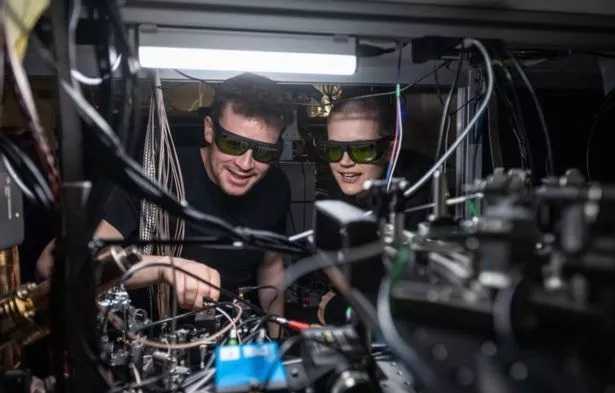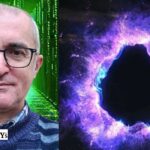Yes, humans have achieved ‘teleportation’ with a quantum supercomputer, but it’s not your Sci-Fi teleportation. Scientists want to teleport an entire human—can they do it? Let’s find out with this new Earth-Shattering discovery!
Scientists at Oxford found a way to connect two separate quantum computers so they can work together as one. They did this using something called quantum teleportation.
But this isn’t the kind of teleportation you see in sci-fi movies—nothing physically moves. Instead, information is transferred instantly from one place to another without actually traveling through space.
Quantum computers are super powerful, but they need millions of qubits to solve big problems. The problem is, cramming millions of qubits into one machine is nearly impossible. Instead of making one giant quantum computer, the researchers figured out how to link multiple smaller quantum computers together—like connecting tiny puzzle pieces to make a bigger, more powerful system.
Scientists have teleported quantum information before, but this is the first time they have teleported logical gates—the basic building blocks of a computer program. This means the linked quantum computers can now work together to run complex programs, just like a single, bigger quantum machine.
In short: They found a way to link quantum computers together using teleportation, making them work as one big system. This could help quantum computers become more powerful and practical in the real world.
Researchers at the University of Oxford connected two separate quantum processors using a special “photonic network interface,” making them work together as one fully connected quantum computer.
This breakthrough could help solve complex problems that regular computers cannot handle. To be truly useful, quantum computers need to process millions of qubits (the basic unit of quantum information). However, fitting so many processors into one machine would make it extremely large.
The new approach links smaller quantum devices together, allowing them to share the work. In theory, this method can connect as many processors as needed.
While quantum teleportation has been done before, this study is the first to teleport “logical gates,” which are the basic building blocks of quantum algorithms, across a network. This could lead to a future “quantum internet,” where distant quantum processors form a super-secure network for communication and computing.

Lead researcher Dougal Main explained that, unlike previous teleportation experiments, their method allows separate quantum systems to interact. By carefully designing these interactions, they created logical quantum gates between qubits in different quantum computers, effectively linking them together as one system.
To test their method, the team ran Grover’s search algorithm, which can find items in large, unorganized datasets much faster than a regular computer. The success of this experiment shows how linking multiple quantum devices can lead to powerful, scalable quantum computers—potentially solving complex problems in hours that would take today’s supercomputers years to complete. (Study)
This is not your Sci-Fi Teleportation but it’s Magical
Scientists first proved that teleportation was possible in 1993. A team from IBM wrote a paper explaining how they could teleport a quantum state (not a physical object). Five years later, researchers from California and the U.K. successfully teleported a photon—a tiny particle of light—through a special cable.
Teleportation, like flying cars and time travel, sounds like science fiction, but scientists believe that improvements in quantum computing could make it real.
So far, most teleportation experiments have used photons. But in 2020, scientists found that teleporting electrons might also be possible. Electrons could be better for teleportation because they can hold their quantum states longer.
Quantum computing is based on the weird science of quantum entanglement, which has nothing to do with our everyday experience of Newtonian mechanics, like masses, forces, and their related effects.
Instead of physically sending qubits from one computer to another, they used quantum teleportation to transfer quantum information instantly. This is possible due to a phenomenon called quantum entanglement, in which two particles (qubits) are mysteriously linked, no matter how far apart they are.
Scientists entangle two qubits (tiny quantum particles). Entangled qubits are like a magical pair—if you change one, the other instantly changes, no matter how far apart they are. This means they stay connected, even if one is on Earth and the other is on the Moon.
They used light (photons) to transfer quantum information between computers. This act acts like a bridge, allowing separate quantum processors to “talk” to each other.
The team didn’t just teleport individual qubits; they teleported logical gates (the basic operations of a quantum computer). This allowed the separate quantum computers to process data together as if they were part of the same system.
Quantum entanglement: Where two particles, such as a pair of photons, remain correlated even when separated by vast distances. This allows them to share information without having to travel physically.
Quantum teleportation: The transfer of quantum information over long distances almost instantly, using entanglement.
Scientists Want to Teleport a Human—Could This Breakthrough Make It Possible?
Moving an entire human from one place to another—like in sci-fi movies—is not possible yet. The human body has about 10^27 atoms, and each atom is made of even smaller particles like electrons, protons, and neutrons. These tiny parts also have their own even smaller parts, like quarks and muons, each with a unique quantum state.
To teleport a person, we’d have to calculate an unimaginably huge number of quantum states and rebuild them perfectly in a new location.
In the past, sci-fi writers thought teleportation meant breaking matter apart, sending it somewhere, and putting it back together. But quantum entanglement shows that teleportation isn’t about moving physical matter—it’s about transferring information that describes a quantum state, according to physicist Paul Davies.
If we can overcome the challenge of processing power—something that better quantum computers might help with—could teleporting a human be as easy as scanning their body and sending the data like an email attachment?
However, a physics rule (the uncertainty principle) says we can’t know both the speed and position of a particle at the same time. This means no matter how carefully we scan every particle in your body, the copy will never be 100% perfect.
What could these small errors mean? Maybe your teleported self looks fine but suddenly enjoys broccoli, even though you used to hate it. Or worse, the errors could be serious, causing big problems when your body is reassembled.
Even if we succeed in addressing all of these challenges, we must consider a philosophical question: do the atoms in your body and all their quantum states constitute the being you consider to be, well, you?
Experimental and theoretical physicist John Clauser—who, along with his colleagues won the 2022 Nobel Prize in physics for their work on quantum entanglement—has a take on this question that might give you pause.
“Imagine you’re told that if you step into this box, every atom in your body will be disassembled, effectively leaving your body totally destroyed, thereby killing you,” Clauser says. “Furthermore, you’re also told that afterwards, a replicant of you starts walking around . . . taking over your life as you once knew it . . . would you step into that box? I certainly wouldn’t!”
Read also:
- This British Scientist Proposes Controversial Theory: We May Be Living 52 Million Lives in a Simulation
- This Man Claims He Has Found Ways to Escape the Simulation, But the Consequences Are Unknown
- This Man finds that Altered States of Consciousness Can Distort Time, And Nobody Knows Why
While the direct teleportation of matter remains speculative, some theoretical frameworks suggest alternative approaches: If the human mind can be fully understood as a quantum system, it might one day be possible to “upload” and “download” consciousness.
Emerging studies in quantum biology suggest that quantum phenomena may play a role in human consciousness.
Dr. Hameroff’s research focuses on the role of microtubules—protein structures within cells—in consciousness. He proposed, alongside Sir Roger Penrose, the Orch OR (Orchestrated Objective Reduction) model of consciousness in the 1990s.
This theory suggests that consciousness arises from quantum computing processes within the brain’s microtubules, with influences from the fundamental structure of spacetime at the quantum level. According to the model, this could explain phenomena like perception, self-awareness, and potentially even spirituality and the afterlife, connecting consciousness to the basic fabric of the universe.
Dr. Stuart Hameroff has been interested in the mystery of consciousness for almost his entire life. Instead of studying brain science or psychology, Hameroff became interested in anesthetics—drugs that cause loss of consciousness—because of their connection to consciousness. (Click here to read the full article)
“I thought about neurology, psychology, and neurosurgery, but none of those seemed to address the problem of consciousness,” says Hameroff, a retired anesthesiology professor from the University of Arizona. He remembers when he first came to the university and met the chair of the anesthesia department. The chair said, “If you want to understand consciousness, figure out how anesthesia works because we don’t know how it works.”
Dr. Hameroff suggests that at its core, consciousness can be understood as “awareness,” which he equates to having a “phenomenal experience”—the subjective, first-person experience of the world around us or our inner thoughts and feelings.
In recent years, research showing quantum effects in biological systems, including microtubules, has given some critics reason to reconsider. Dr. Hameroff believes the focus on AI and computation has shifted attention away from the true nature of consciousness. Despite the criticism, he continues to defend the theory, even exploring the possibility that consciousness could predate life itself, a view he admits leans into the spiritual realm
Quantum Entanglement in Neurons May Actually Explain Consciousness
In their newly published paper, Shanghai University physicists Zefei Liu and Yong-Cong Chen and biomedical engineer Ping Ao from Sichuan University in China explain how entangled photons emitted by carbon-hydrogen bonds in nerve cell insulation could synchronize activity within the brain. (Source)
Their findings come just months after another quantum phenomenon known as superradiance was identified in cellular frameworks, drawing attention to a highly speculative theory on consciousness called the Penrose-Hameroff ‘orchestrated-objective reduction’ model.
Scientists have had a whole other reason to staple their skeptic hat on tight when it comes to quantum theories of consciousness – the sloppy tides of biology have long been considered too chaotic, too noisy, and too ‘big’ for quantum mechanics to emerge in any significant way.
Proposed by the highly respected physicist Roger Penrose and the American anesthesiologist Stuart Hameroff, the model suggests networks of cytoskeleton tubules that lend structure to cells – in this case, our neurons – act as a kind of quantum computer that somehow shapes our thinking.
The movement of these connected photons through the brain’s biochemistry might help link processes that are important for the brain’s ability to synchronize.
The word “might” is doing a lot of work here. While there are many scientific discoveries that support parts of this idea, there’s currently only evidence that entangled photons affect biological processes in photosynthesis.
That doesn’t mean there aren’t examples of quantum biology in animals. There is growing evidence that the electron spins in certain proteins, called cryptochromes, can be affected by magnetic fields, which may help explain how some animals navigate long distances.
We’re still far from proving that anything beyond classical chemistry happens in our brains, or that our brain functions are controlled by a quantum force. But it may be time to reconsider whether quantum phenomena have any impact on at least some of the brain’s basic functions.








